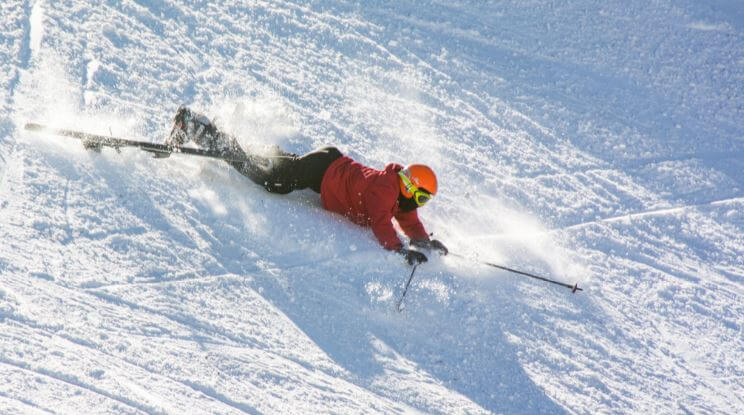5 Dangerous Sports

The inexhaustible list of man-made sports harbors disciplines that can be deadly. High speeds, dangerous movements, and pronounced heights are decisive variables when it comes to dangerous sports.
In fact, there are statistics that show the levels of danger that each discipline implies. It’s true that in sports such as soccer and basketball there is a risk of injuries, however, the following disciplines can lead to many unexpected outcomes.
The most dangerous sports you can play
Base jumping could be the most dangerous sport of all
The base jump is a parachuting variant. It involves jumping into a void from a certain point. It’s is called B.A.S.E because of the different places where practitioners can jump from. The letters stand for building, antenna, span (bridges), and earth (this could be from hills or cliffs).
Base jumps are performed with special outfits which allow the practitioner to glide with the wind, and a parachute. Part of the danger of base jumping is the short distance between the launch point and the ground. Jumps are usually over a distance of 60 to 70 meters.
Parachutists have little time to react and their fall speeds depend on many variables including wind speeds. Since the creation of sports, it’s estimated that a little more than 200 people have lost their lives during jumps. The odds of dying practicing base jumping is one in 560.

Mountaineering has taken the lives of its greatest champions
The record of dead mountaineering experts is quite extensive and well known. It’s said that one of every six ascents up to Mount Everest is fatal. The danger is not only caused by the high altitude, but also by the intense physical and mental demand of the sport.
Mountaineers say that the greatest risks are not experienced while ascending, but rather on the descents. Deaths during mountaineering can be caused by several reasons including falls, hypothermia and lack of oxygen.
A lot of champions and innovators of mountaineering have lost their lives in the mountains. According to the National Center for Health Statistics, the probability of dying climbing a mountain is one in 1750. For those who climb in Nepal, the statistic is one in 167.

Heli-skiing combines snow with high altitude sports
In practice, snow sports are often not as dangerous compared to others. However, heli-skiing is not an average snowsport. The danger is due to the combination of snow with high altitudes.
During heli-skiing, practitioners land on the snow and maneuver the slopes at high speeds. From the beginning of the run, athletes are in danger. They risk falling incorrectly or not being able to maneuver due to high wind speeds.
Even after landing, there’s the danger of maneuvering downhill at high speeds. Any incorrect movements could cause an accident.

The uneven terrain is another challenge for heli-skiing athletes. Without a doubt, heli-skiing is one of the most dangerous sports that exists.
Speed disciplines: Formula One and motorcycling
Driving to work is low risk, however, driving at high speeds in a closed competition is very dangerous. Those who do so in Formula One races have a one in 100 chance of dying in an accident. This statistic is even more discouraging than mountaineering.
Motorcycle racing, on the other hand, has a wider but equally dangerous margin. According to the US statistics mentioned above, the probability of mortality in motorcycle races is one in 1000.

Less safe sports: boxing and its high mortality rate
Although it doesn’t involve speed and heights, boxing is a demanding discipline. In 1976 a Spanish columnist that wrote for a very popular newspaper claiming that 500 boxers had died.
There’s no clear record about the mortality rate when it comes to this discipline. However, according to the statistics, one in 2,200 could die while boxing. This doesn’t include the consequences of repeated brain trauma.

There are other traditional sports that also show alarming statistics. For example, attention is now being paid to the consequences that American football players face. However, it’s a completely personal decision when it comes to deciding to practice any one of these sports.
The inexhaustible list of man-made sports harbors disciplines that can be deadly. High speeds, dangerous movements, and pronounced heights are decisive variables when it comes to dangerous sports.
In fact, there are statistics that show the levels of danger that each discipline implies. It’s true that in sports such as soccer and basketball there is a risk of injuries, however, the following disciplines can lead to many unexpected outcomes.
The most dangerous sports you can play
Base jumping could be the most dangerous sport of all
The base jump is a parachuting variant. It involves jumping into a void from a certain point. It’s is called B.A.S.E because of the different places where practitioners can jump from. The letters stand for building, antenna, span (bridges), and earth (this could be from hills or cliffs).
Base jumps are performed with special outfits which allow the practitioner to glide with the wind, and a parachute. Part of the danger of base jumping is the short distance between the launch point and the ground. Jumps are usually over a distance of 60 to 70 meters.
Parachutists have little time to react and their fall speeds depend on many variables including wind speeds. Since the creation of sports, it’s estimated that a little more than 200 people have lost their lives during jumps. The odds of dying practicing base jumping is one in 560.

Mountaineering has taken the lives of its greatest champions
The record of dead mountaineering experts is quite extensive and well known. It’s said that one of every six ascents up to Mount Everest is fatal. The danger is not only caused by the high altitude, but also by the intense physical and mental demand of the sport.
Mountaineers say that the greatest risks are not experienced while ascending, but rather on the descents. Deaths during mountaineering can be caused by several reasons including falls, hypothermia and lack of oxygen.
A lot of champions and innovators of mountaineering have lost their lives in the mountains. According to the National Center for Health Statistics, the probability of dying climbing a mountain is one in 1750. For those who climb in Nepal, the statistic is one in 167.

Heli-skiing combines snow with high altitude sports
In practice, snow sports are often not as dangerous compared to others. However, heli-skiing is not an average snowsport. The danger is due to the combination of snow with high altitudes.
During heli-skiing, practitioners land on the snow and maneuver the slopes at high speeds. From the beginning of the run, athletes are in danger. They risk falling incorrectly or not being able to maneuver due to high wind speeds.
Even after landing, there’s the danger of maneuvering downhill at high speeds. Any incorrect movements could cause an accident.

The uneven terrain is another challenge for heli-skiing athletes. Without a doubt, heli-skiing is one of the most dangerous sports that exists.
Speed disciplines: Formula One and motorcycling
Driving to work is low risk, however, driving at high speeds in a closed competition is very dangerous. Those who do so in Formula One races have a one in 100 chance of dying in an accident. This statistic is even more discouraging than mountaineering.
Motorcycle racing, on the other hand, has a wider but equally dangerous margin. According to the US statistics mentioned above, the probability of mortality in motorcycle races is one in 1000.

Less safe sports: boxing and its high mortality rate
Although it doesn’t involve speed and heights, boxing is a demanding discipline. In 1976 a Spanish columnist that wrote for a very popular newspaper claiming that 500 boxers had died.
There’s no clear record about the mortality rate when it comes to this discipline. However, according to the statistics, one in 2,200 could die while boxing. This doesn’t include the consequences of repeated brain trauma.

There are other traditional sports that also show alarming statistics. For example, attention is now being paid to the consequences that American football players face. However, it’s a completely personal decision when it comes to deciding to practice any one of these sports.
All cited sources were thoroughly reviewed by our team to ensure their quality, reliability, currency, and validity. The bibliography of this article was considered reliable and of academic or scientific accuracy.
- Rafael Verdera Server. Riesgos del deporte. Facultad de Ciencias Jurídicas. Universidad de Las Palmas de Gran Canaria. Extraído de: http://www.indret.com/pdf/116_es.pdf
- Joan Ruis Sant. Riesgo y peligro en el deporte. Extraído de: http://www.jriustrainer.com/sites/default/files/pdf/Riesgo%20y%20peligro%20%20en%20el%20deporte.pdf
This text is provided for informational purposes only and does not replace consultation with a professional. If in doubt, consult your specialist.








